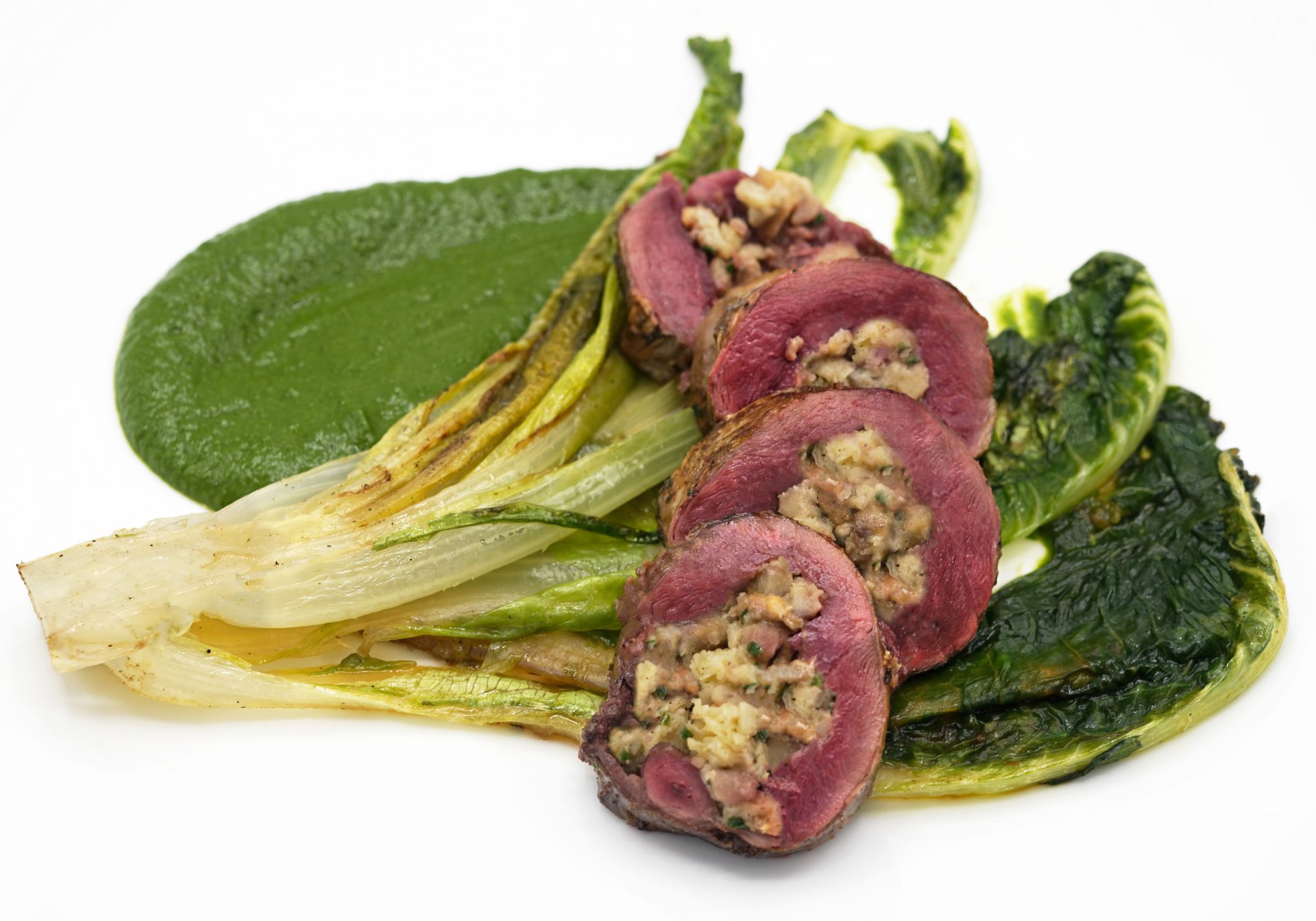With about a foot of snow covering New York City right now, I have to face facts: winter’s here, and it’s time to stop posting about sunny Croatia and Mediterranean cuisine until next summer! So I’ll be getting back to my recipes from the Russian Far North soon, and as a preamble, here’s a Russian-ish holiday game recipe, inspired by two entries from The Derrydale Game Cookbook: Grouse à la Moscovite and Braised Lettuce à la Russe.
This isn’t the first time I tap into The Derrydale Game Cookbook – some of this blog’s first recipes included a pheasant à la Russe and a partridge breast and dumplings in Tokaji sauce. But let me say a few words about its author, Louis Pullig De Gouy. De Gouy (born in 1869 in France; died in 1947 in New York City) began his career as a chef under his father, Jean de Gouy, Esquire of Cuisine to Emperor Francis Josef of Austria. He then apprenticed under the famous Auguste Escoffier before working in some of the greatest culinary establishments in Europe and America. His longest tenure was his 30 year association with the Waldorf-Astoria Hotel. He was also Gourmet Magazine‘s first chef when it was founded in January 1941, a consulting editor and chef for Restaurant Management Magazine, and a consulting chef for the National Hotelmen Association of America. He left behind thousands of recipes, many of which were published posthumously in several cookbooks. You can check out this article for more details. And as if all that wasn’t enough, in his spare time, De Gouy traveled extensively across Russia to document the culinary habits of its diverse and multi-ethnic population, from Nicholas II’s table to the muzhik‘s humble gruel…

…Or, no, he didn’t. In fact, I’ve found no evidence that he ever went to Russia. But just like his mentor, Escoffier, De Gouy perpetuated the habit of calling “Russian this” and “Muscovite that” (probably interchangeably) a number of recipes that the European imagination had at some point associated with anything remotely Russian. Russia being known for its varied feather and fur game, The Derrydale Game Cookbook is peppered with these more or less fanciful “Russian” recipes. Grouse stuffed with chestnuts and bread soaked in cream sauce can pass for something that would be served at the tsar’s court. On the other hand, I’m more doubtful about Iceberg lettuce braised in chicken stock and tossed in spinach purée, especially considering that the Russian language uses imported words for lettuce, spinach, and purée!
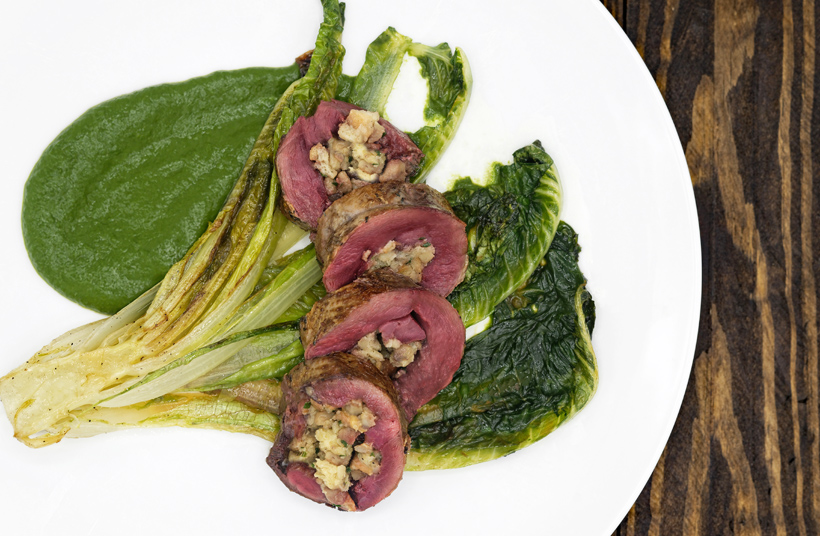
I’ve taken some liberties with De Gouy’s recipes. The original grouse à la Moscovite calls for tarragon and pistachios in the stuffing, and is wrapped in pork fat rubbed with vodka – I’ve skipped all that. A few pages further in the cookbook, however, a grouse à la Pavlova (“used to be the favorite dish of the famous, indisputably the greatest dancer in living memory, of the Ballets Russes, Anna Pavlova”; though since nobody except De Gouy mentions the recipe, it’s more likely that this was just be a dish that he served to the ballerina at one of his restaurants one time) is stuffed with bread soaked in cream sauce (again) and goose liver, and this inspired me to add foie gras to my own stuffing. The braised lettuce à la Russe seems to be the recommended accompaniment to the grouse à la Pavlova, and my main change to that recipe has been to keep the spinach purée separate, lest the dish looks like an unappetizing green mess.
Finally, as grouse is a rare and expensive delicacy, it makes sense to try to use every part of the animal. I have a friend who religiously sucks every bone of the grouse once he’s done with his meal, attempting with hissing suction sounds to extract every last drop of juice, every last particle of meat. The grouse à la Moscovite is entirely boned, which leaves us with the carcass and offal – plus the wings and drumsticks (whose meat is so tough that I consider it inedible if it’s not cooked in its own distinct preparation). Discarding them would be heresy! So in a second service, I’m preparing a strong, reduced grouse broth, served in a little liqueur glass, with a cube of seared foie gras on a skewer, as a memento of the glorious bird. The most motivated among you, dear readers, could even grind the drumstick meat and put it back on the bone to make a kind of game lollipop.
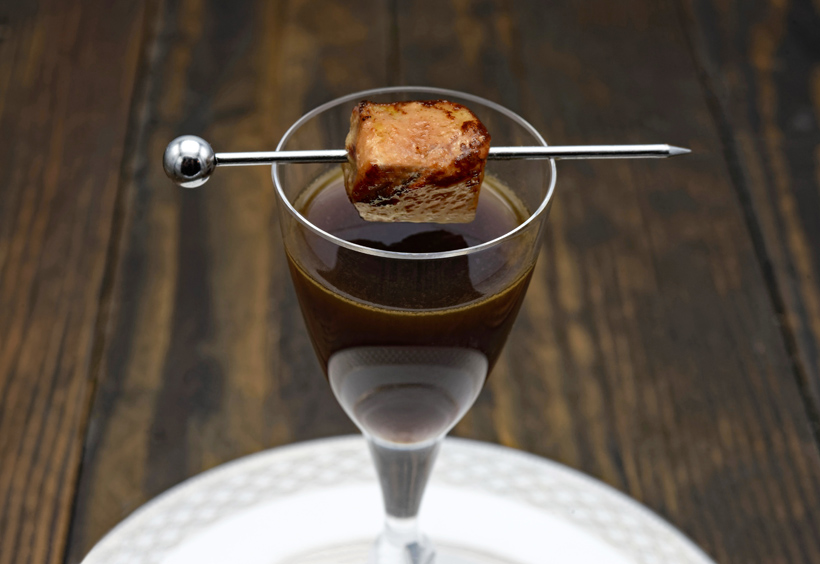
Smitane sauce
Yields about 300 g (4 servings)
150 g peeled onions, small dice
15 g butter
125 g white wine
150 g chicken stock
200 g heavy cream
salt
black pepper, ground
- In a saucepan over medium heat, sauté the onions in the butter until soft. Add the white wine and reduce almost completely.
- Add the chicken stock and heavy cream, bring to a gentle boil, then turn down the heat and simmer for 10 minutes.
- Pass the sauce through a chinois, pressing with a ladle to squeeze as much liquid out of the onions as possible. You should have 300 g of sauce. If you have over 300 g, reduce it some more in a clean saucepan. If you have less, add some chicken stock.
- Season the sauce with salt and pepper (the original recipe insists on doing this last) and reserve.
Grouse fabrication
Yields 4 servings
2 whole grouse
- Take the offal out of the bird, if present. Cut off the wings and drumsticks. Position each bird on its breast, and separate the meat from the carcass, starting from the middle and dislocating the thigh bones as you progress. Once you’re done, the breast and thighs should still be attached together as one (you can watch this video to get a better idea of how it should be done.)
- Remove the thigh bones and any remaining pieces of bone. Remove the silverskin from the tenders, and run your finger along the flesh to locate any buckshots or tiny pieces of broken bone that might remain.
- Cut each carcass in half, and reserve the offal, carcasses, bones, wings, and drumsticks for the grouse stock.



Stuffed grouse
Yields 4 servings
35 g French baguette, small dice
90 g smitane sauce
80 g cooked chestnuts, small dice
50 g raw foie gras, medium dice
5 g chives, minced
salt
black pepper, ground
boned grouse
- Toast the baguette dice in a 175 C / 350 F oven until crispy, for about 6-8 minutes.
- Microwave the smitane sauce to warm it, and soak the chestnuts in the sauce for 15 minutes.
- In a bowl, combine the smitane sauce and chestnuts, toasted baguette dice, foie gras, and chives. Season with salt and pepper.
- Spread each boned grouse open and shape like a rectangle, using the tenders to fill the less fleshy parts. Season with salt and pepper, then fill with a generous amount of stuffing. Press the stuffing with your hand, and fold the meat over to cover it completely (see photos below). You might have a little bit of stuffing left.
- Tie the stuffed grouse with butchers twine, wrap very tightly in two layers of plastic film, and refrigerate for at least 2 hours.
Reduced grouse stock
Yields about 150 g (over 4 servings)
grouse offal, carcasses, bones, wings, and drumsticks (about 275 g)
15 g canola oil
75 g peeled shallots, large dice
100 g cleaned cremini mushrooms, quartered
salt
black pepper, ground
1 clove
2 sprigs thyme
100 g red port wine
300 g chicken stock
- In the pot of a pressure cooker over high heat, sauté the offal, carcasses, bones, wings, and drumsticks in canola oil until brown on all sides. Add the shallots and mushrooms, season with salt and pepper, and cook for a couple minutes, stirring constantly. Add the clove, thyme, and red port wine, and let the wine reduce (this takes only a few seconds).
- Add the chicken stock, bring to a simmer, then cover, bring to pressure, and cook under pressure for 1 hour.
- Let cool for 30 minutes, then pass through a chinois, discarding the solids. You should have about 350 g of stock.
- Optionally, filter the stock through a coffee filter or a fine filter bag.
- Transfer to a saucepan, and reduce to 150 g over medium-high heat.
- Transfer to a pint container, let cool, and refrigerate for at least 12 hours.
Sous-vide stuffed grouse
Yields 4 servings
stuffed grouse
- Place each grouse, still wrapped in plastic film, into a sous-vide pouch, and vacuum-seal.
- Cook in a 50 C / 122 F water bath for 2 hours. Reserve in the water bath until the final assembly steps.
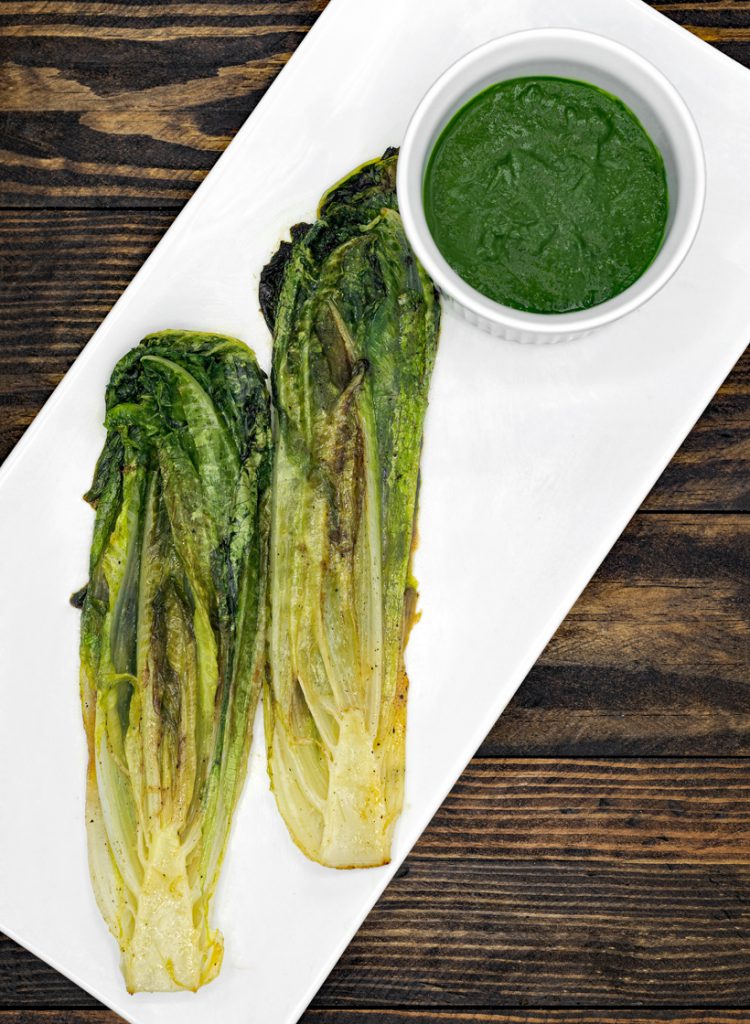
Spinach purée
Yields 4 servings
40 g peeled shallots, small dice
25 g butter
170 g cleaned, picked spinach, coarsely chopped
125 g chicken stock
30 g raw foie gras
5 g chives, coarsely chopped
salt
black pepper, ground
- In a saucepan over medium heat, sweat the shallots in butter. Add the spinach and cook until wilted.
- Add the chicken stock and simmer for 3-4 minutes until almost fully reduced (i.e., no liquid visible in the pan, but not dry).
- Transfer the spinach and shallots to a blender. Add the foie gras and chives, season with salt and pepper, and blend on high speed until smooth. Pass through a chinois, transfer to a pint container, and reserve.
- If you’re not using the purée immediately, cool in an ice water bath and refrigerate.
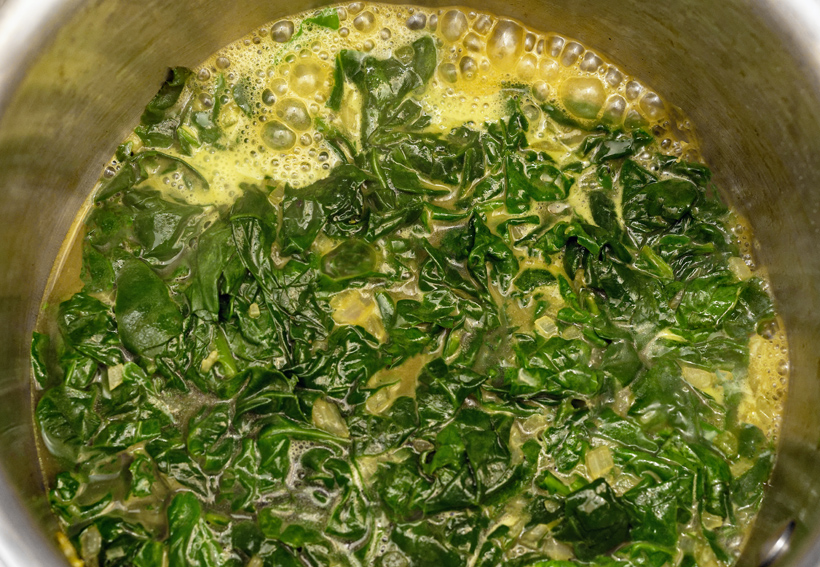
Braised lettuce à la Russe
Yields 4 servings
2 romaine hearts (about 450 g)
25 g butter
70 g chicken stock
salt
black pepper, ground
2.5 g lemon juice
- Halve each romaine heart lengthwise.
- Melt 2/3 of the butter in a pan over medium heat. Add the romaine hearts cut side down, and cook, flipping once, until they begin to brown on the edges, about 5 minutes.
- Add the chicken stock, and season with salt and pepper. Cover with a lid ajar, and cook over the lowest possible heat until the lettuce is very tender, about 15 minutes, flipping it once around midtime.
- Remove the lid, add the remaining butter, and turn the heat up to medium. Use a spoon to baste the lettuce with the sauce until there is no liquid left. Drizzle with lemon juice and proceed with instructions below.
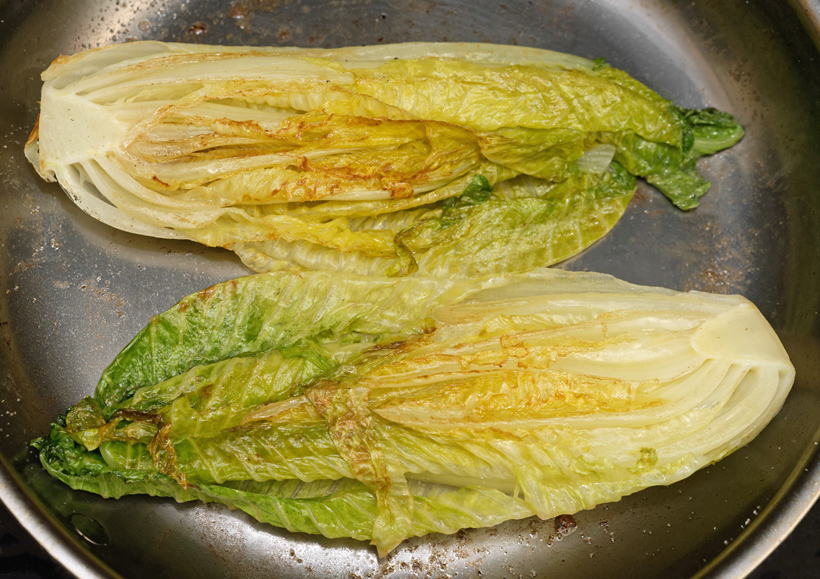
Grouse à la Moscovite and braised lettuce à la Russe
Yields 4 servings
sous-vide stuffed grouse
salt
15 g butter
10 g canola oil
smitane sauce (the rest, about 200 g)
25 g birch syrup
spinach purée
braised lettuce à la Russe
about 2 g chives, finely chopped
- Remove the grouse from the sous-vide pouch and plastic wrap, and season with salt.
- Heat the butter and the canola oil in a pan over medium heat. Sauté the grouse, using a spoon to baste, until golden brown on all sides. Remove from the pan and let rest for a few minutes.
- Combine the smitane sauce and the birch syrup in a saucepan and heat over low heat.
- Reheat the spinach purée in the microwave.
- Reheat the braised lettuce in the pan for a minute, if needed.
- Cut the grouse into 1-1.5 cm thick slices. You want to get about 8 nice slices out of each grouse.
- On each plate, serve a generous spoonful of spinach purée and spread into a teardrop shape using the back of a spoon. Fan a braised lettuce half next to it. Arrange four slices of grouse across the lettuce, top with sauce and sprinkle with chives.
- Alternative presentation: place the grouse slices and sauce in the center of each plate, and serve the braised lettuce and spinach purée in a separate serving dish.
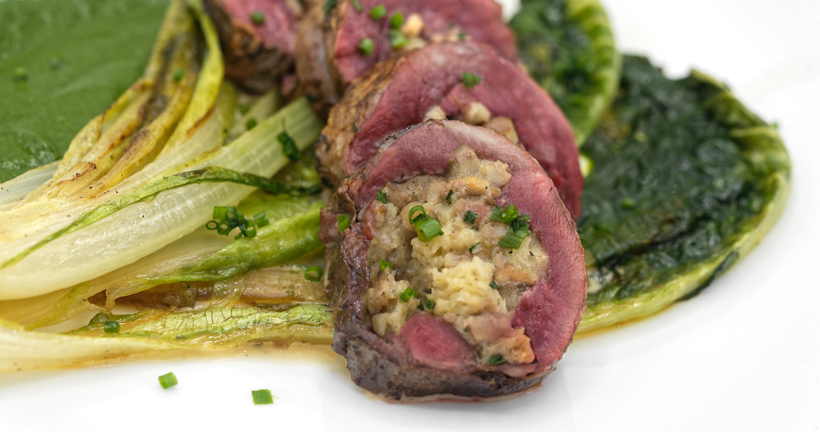
Strong grouse broth with foie gras (to serve after the grouse)
Yields 4 servings
4 dice raw foie gras (2 cm each, about 30 g total)
salt
100 g reduced grouse stock
16 g birch syrup
- Season the foie gras dice with salt, and sauté in a pan over high heat until brown on all sides. Reserve.
- Combine the reduced grouse stock with the birch syrup and reheat in the microwave. Pour into small liqueur glasses.
- Place each glass on a small plate, and garnish with a cube of foie gras on a cocktail skewer.


